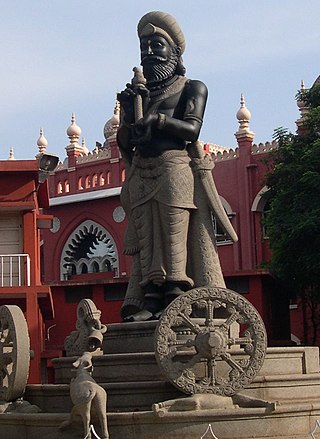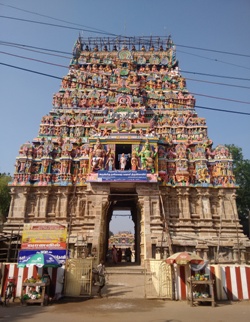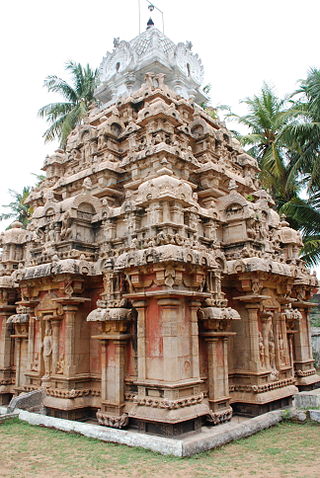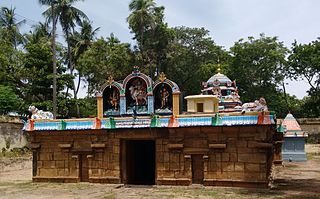
Thiruvaiyaru is a panchayat town in Thanjavur District in the Indian state of Tamil Nadu.
Navagraha (Pron: nævəˈgrɑ:ə) pilgrimages are pilgrimages devoted to Navagraha—the nine (nava) major celestial bodies (Grahas) of Hindu astronomy. These temples are made of stone. These celestial bodies are named Surya (Sun), Chandra (Moon), Mangala (Mars), Budha (Mercury), Brihaspati (Jupiter), Shukra (Venus), Shani (Saturn), Rahu and Ketu. Many temples in South India contain a shrine dedicated to the Navagrahas. However, the term Navagraha temples refers to a cluster of nine separate temples, each an abode of one of the Navagrahas.

Karikala, often referred to as Karikala the Great, was a Tamil Emperor of the Early Cholas of the Chola dynasty who ruled ancient Tamilakam from Uraiyur. He is credited with the construction of the flood banks of the river Kaveri and conquest of Tamilakam, Andhra and Sri Lanka. He is recognised as the greatest of the Early Cholas. In Thiruvalangadu plates of Rajendra Chola I, Medieval Tamil Cholas listed Karikala Chola as one of their ancestors.

Ellalan, also referred to as Elara the Pious, and by the honorific epithet Manu Needhi Cholan, was a member of the Tamil Chola dynasty in Southern India, who upon capturing the throne became king of the Anuradhapura Kingdom, in present-day Sri Lanka, from 205 BCE to 161 BCE.

Draksharamam or Daksharamam (దక్షారామం) is one of the five Pancharama Kshetras that are sacred to the Hindu god Shiva and also 12th of Ashtadasha Shakthi Peetams. The temple is located in Draksharamam town of Konaseema district in the Indian state of Andhra Pradesh. Bhimeswara Swamy refers to Lord Shiva in this temple. Poet Mallikarjuna Panditaradhyudu who wrote first independent work in Telugu and who spread Veerasaivism in Andhra region during medieval ages was born in this town.
Kalyana Varadharaja Perumal Temple is a temple in Paruthiyur, Sengalipuram, Thiruvarur District, India. The temple is located on the banks of the Kudamurutti River, a distributary of the River Kaveri.
Sengalipuram Vaidhyanatha Deekshithar , also Sengalipuram Muthanna or Muthannaval (1830–1893), was a great guru from the family of Dikshitar from Sengalipuram near Paruthiyur, on the northern banks of the Kudamurutti River, in Thiruvarur District of Tamil Nadu.

Airavatesvara Temple is a Hindu temple of Chola architecture located in Kumbakonam, Thanjavur District in the South Indian state of Tamil Nadu. This temple, built by Chola emperor Rajaraja II in the 12th century CE is a UNESCO World Heritage Site, along with the Brihadeeswara Temple at Thanjavur, the Gangaikondacholisvaram Temple at Gangaikonda Cholapuram that are referred to as the Great Living Chola Temples.

Anandavalleeswaram Sri Mahadevar Temple in Kollam city is one of the ancient Hindu temples in Kerala, India. Lord Siva and Goddess Anandavally are the main deities of the temple. According to folklore, sage Parashurama has installed the idol of Lord Shiva. The temple is a part of the 108 famous Shiva temples in Kerala. It is located at Anandavalleeswaram, a major neighborhood of Kollam city, that comes to the west side of Kollam Collectorate.

The Sri Srinivasa Perumal Temple in Kudavasal, Tamil Nadu, India is a Hindu temple dedicated to Srinivasa, a form of the god Vishnu. The temple is glorified by The son of Pulastya Maharishi Kubera and classified as one of the 108 Abhimana Kshethrams of the Vaishnavate tradition. Kudavasal is a small town located in the Thiruvarur district, in between two distributaries of Kaveri river, Kudamurutti and Chola Choodamani. Srinivasa appears with his consorts Sridevi and Bhudevi.
Raja Mannargudi Mahamahopadhyaya Thyagaraja Mahi Raju Sastrigal, also known as Mannargudi Raju Sastri or Mannargudi Periyaval, was a Hindu scholar. He was born in the Bharadwaja Vamsa, as a descendant of Adayappaalam Sri Appayya Dikshitar. Raju Sastri was born in the village of Kuthambadi in today's Thiruvarur district as son of Maragathavalli Janakiammal and Sri Markasahaya Appa Dikshitar

Thyagaraja Temple is a Shiva temple, located in the town of Thiruvarur in Tamil Nadu state, India. Shiva is worshiped in the form of a lingam as Thyagarajaswami, also known as Putridankondar. His consort Parvati is worshipped as Goddess Neelotpalambika. She is also worshipped as Goddess Kamalambika, whose separate shrine is an important center for Shaktism and Tantra, and is also regarded to be one of the Shakti Peethas. The presiding deity is revered in the 7th century Shaiva canonical work, the Tevaram, written in Tamil by saint poets known as the Nayanars and the shrine is classified as a Paadal Petra Sthalam.

The Nanjundeshwara Temple is an ancient temple dedicated to Shiva in the Hindu pilgrimage town of Nanjanagudu in Karnataka, India. It is located on the right bank of the Kabini River, a tributary of the Kaveri River. Nanjanagudu is also known as "Dakshina Kashi" or "Kashi of South".

Nageswaraswamy Temple is a Hindu temple dedicated to Shiva located in Kumbakonam in Thanjavur district, Tamil Nadu, India. The presiding deity is revered in the 7th-century Tamil Saiva canonical work, the Tevaram, written by Tamil poet saints known as the nayanars and classified as Paadal Petra Sthalam. The temple is counted as the earliest of all Chola temples. Shiva in the guise of Nagaraja, the serpent king..

Tirunageswaram Naganathar Temple also known as Rahu Stalam is a Hindu temple dedicated to the deity Shiva, located in Tirunageswaram, a village in the outskirts of Kumbakonam, a town in Tamil Nadu, India. It is significant to the Hindu sect of Saivism as one of the temples associated with the nine planet elements, the Navagraha Stalas, and specifically Rahu. Shiva is worshiped as Naganathar, and is represented by the lingam. His consort Parvati is depicted as Piraisoodi Amman. The presiding deity is revered in the 7th-century Tamil Saiva canonical work, the Tevaram, written by Tamil saint poets known as the nayanars and classified as Paadal Petra Sthalam.

Tirupullamangai or Thirupullamangai is a Hindu temple dedicated to Lord Siva located at Pullamangai, in Pasupathikoil, Papanasam taluk of Thanjavur district, Tamil Nadu, India. It is one of the shrines of the 275 Paadal Petra Sthalams - Shiva Sthalams glorified in the early medieval Tevaram poems by Tamil Saivite Nayanar Tirugnanasambandar.

Chakramangai or Chakravageswarar Temple is a Hindu temple dedicated to Hindu deity Shiva and is located in Chakkarapalli, Papanasam taluk of Thanjavur district, Tamil Nadu, India. The temple is incarnated by the hymns of Thevaram, the 7th century Tamil literature and is classified as Paadal Petra Sthalam. It is one of the 275 Paadal Petra Sthalams, where the three of the most revered Nayanars, Appar and Tirugnana Sambandar have glorified the temple with their verses during the 7th-8th century. The temple has been widely expanded by Chola kings during the 11th century.
Eyarkon Kalikkama Nayanar, also known as Kalikkamanar, Kalikamba Nayanar, was a King of Haihaya (Eyar), Commander-in-chief of the Chola army, a Nayanar saint, venerated in the Hindu sect of Shaivism. He is generally counted as the 29th in the list of 63 Nayanars.
Kundrathur Nageswarar Temple, also known as Vada Thirunageswaram, is a Hindu temple dedicated to Shiva, located in the neighbourhood of Kundrathur in Chennai, India. The temple was built in the 12th century by the Shivite saint Sekkilar and is modelled on the Thirunageswaram temple at Kumbakonam.












